Understanding and Managing Pomeranian Aggression Issues
Lateef Bhatti
Author
Territorial instincts, fear, or lack of socialization are often the main reasons behind Pomeranian aggression issues. Understanding why a Pomeranian becomes aggressive helps owners respond calmly and effectively. This guide explores the causes, types, and signs of Pomeranian aggression issues while outlining proven training and positive reinforcement techniques. With consistent routines, proper socialization, and professional guidance if needed, owners can manage biting, anxiety, and territorial behavior—building a confident, happier, and well-balanced Pomeranian over time
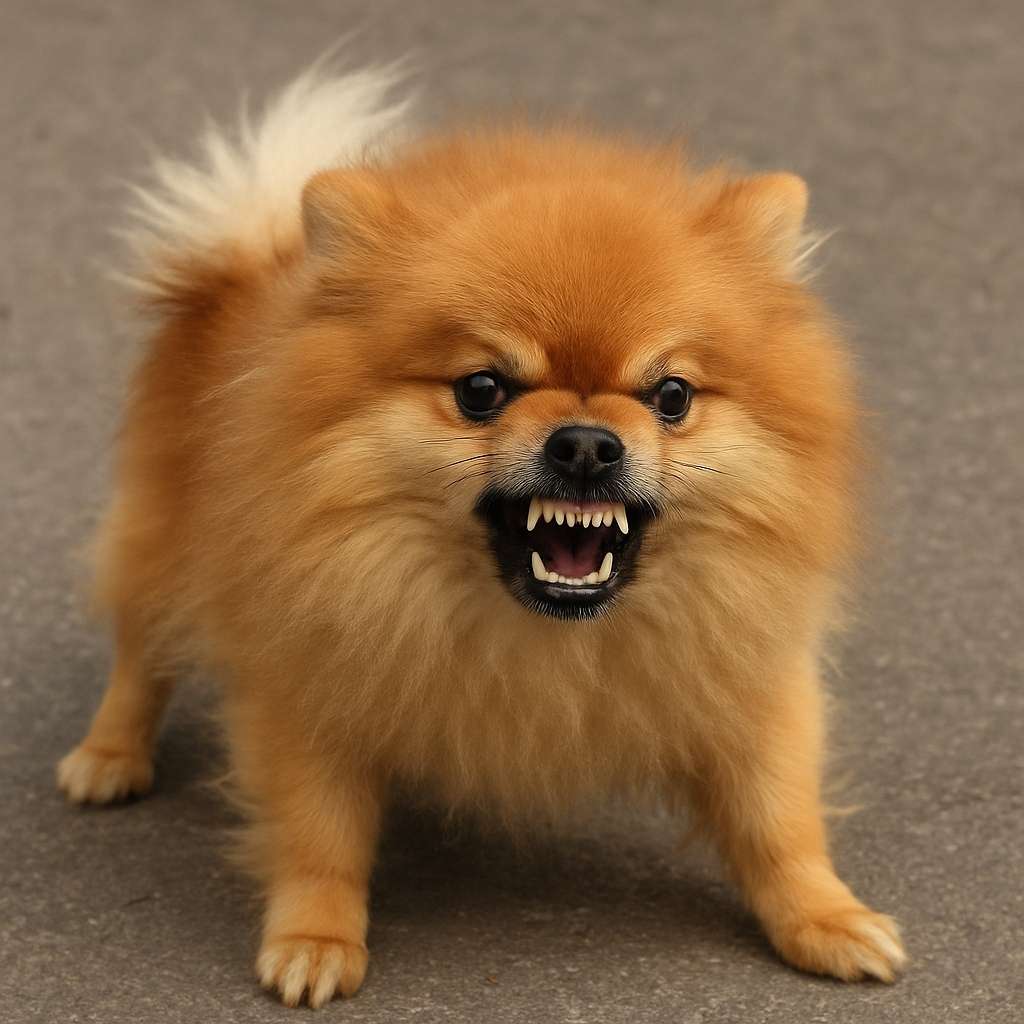
Pomeranians, like any other small dog breeds, will have aggressive behaviors and attitudes that will need to be corrected. Learning about these behaviors, attitudes, and corrections is important.
Table of Contents
ToggleUnderstanding small dog aggression is important to help them adapt to a more social and relaxed attitude. Aggression can be shown through: biting, snapping, and growling. Managing these behaviors can be hard and stressful; therefore, identifying the key issues quickly will be beneficial.
Social Defects like a Dog or Puppy having an aggressive or unfriendly attitude can be caused by different things, for example: fear, or territorial instincts, and social defects can all trigger an aggressive response. Finding the cause is the first most important step to take in correcting an aggressive dog, like a Pomeranian.
Socializing a dog, or any other small dog breed, or Pomeranian can absolutely help in the prevention of it developing aggressive behaviors. Active training and correction/structured systems help in training the aggressive attitude and creating a more social one.
Sessions with aggressive Pomeranians can be stressful, and that is why having a more calm and protective and ordered correction when aggressive Pomeranians will really help. Also, giving the dog, or Pomeranian, a more stable home will aid in reducing the created aggression.
Understanding Aggression in Pomeranians
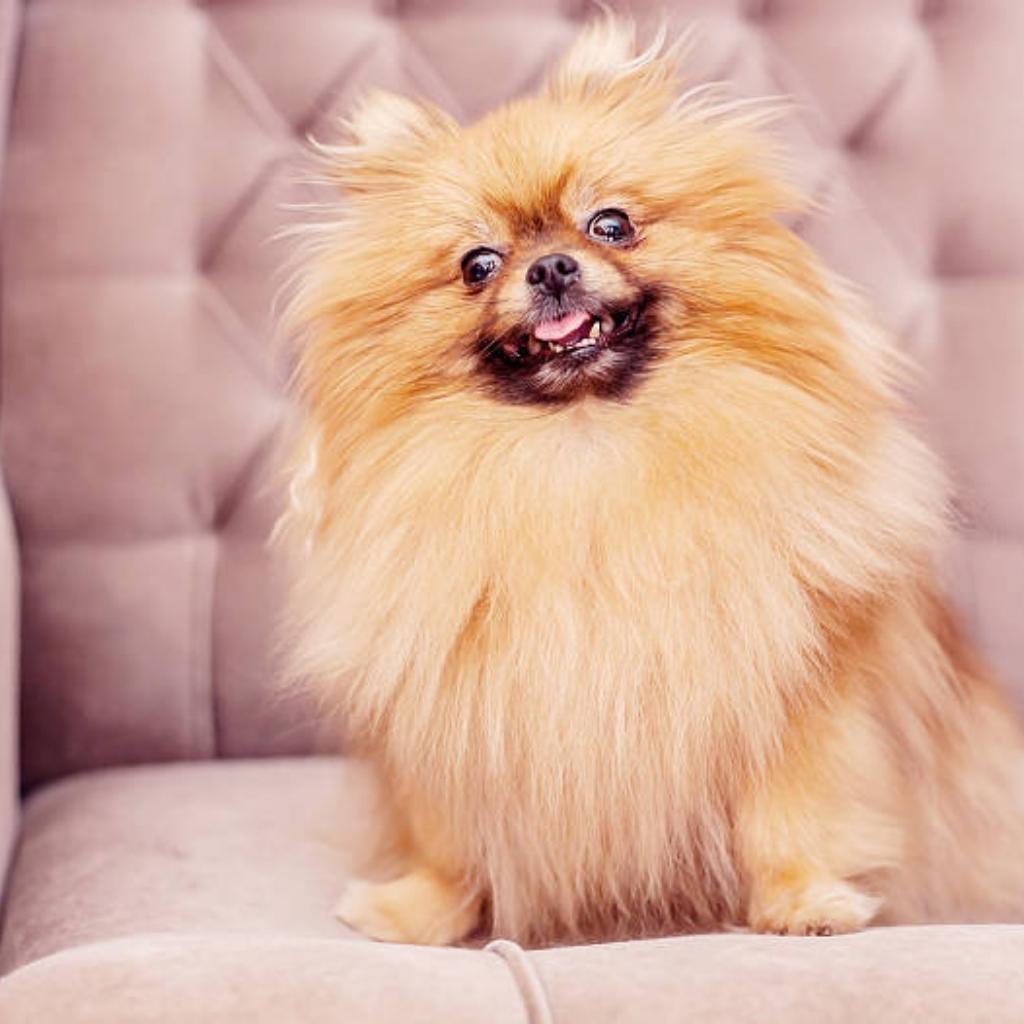
When it comes to Pomeranians, aggression is a complex behavior. It may not comprehend aggression as simply mean or angry. There are fundamental factors, sometimes connected to how the dog views its surroundings.
In Pomeranians, aggression may take the form of barking, biting, or lunging toward something. Such behavior typically occurs when a challenge is posed to the dog or the environment is seen as threatening. It is critical to understand that aggression is primarily communicative in these scenarios.
Pomeranians may behave aggressively due to fear, anxiety, or a need to defend their territory. Gaining a strong understanding of the underlying issues will help in managing the behavior in the most appropriate manner.
In Pomeranians, aggression seen in body language such as tension, or the showing of teeth or fixated staring, needs to be recognized as early recognition of these signs will help in avoiding dangerous situations.
Ignoring or downplaying aggression will not make the situation better. It needs to be worked on through training to help the Pomeranian and the dog owner live in compliance.
Common Signs of Pomeranian Aggression
Growling is a clear sign of aggression. This vocal sign of communication means the animal is uncomfortable or is on the verge of agitation. If the situation is allowed to continue and the animal is not addressed, it may develop into greater aggression.
Another sign of aggression is snapping and biting. This action is often a last resort action for a dog and as such, understanding this action is a key to addressing the situation from the root.
Body language can communicate a lot regarding aggression as well. A body that is rigid, hackles that are raised, or intense staring challenges can all speak toward aggression. These signs are often overlooked and can speak volumes regarding the strain or threat an animal may feel.
Growling and snapping, baring teeth, biting or snapping, rigid posture and intense eye contact can all be signs of composite aggression.
Another sign of aggression that can be performed is outburst to stimuli. These triggers can be a certain sound or a sudden movement.
Identifying and understanding this behavior is a key to preventing a conflict before it escalates.
Types of Aggression in Pomeranians
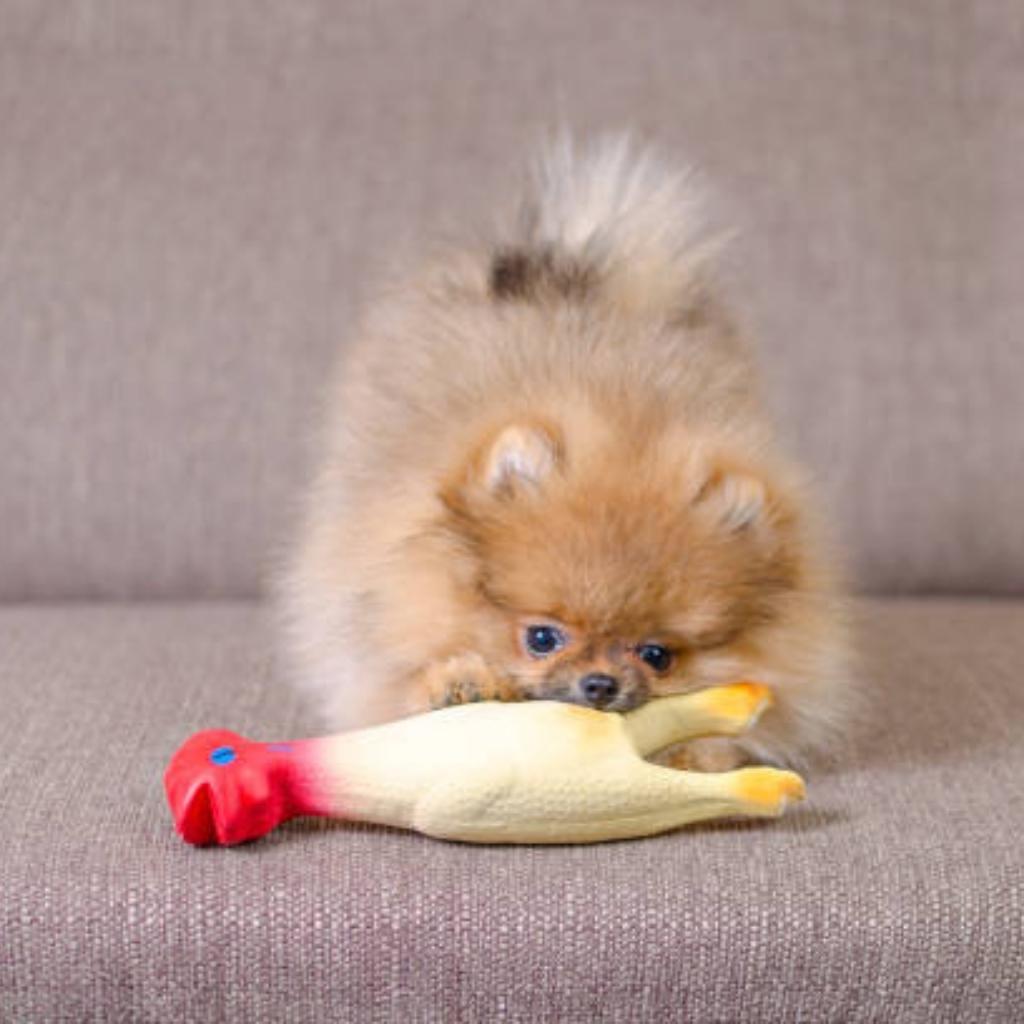
A Pomeranian can show different forms of aggression as well. If aggression is better understood, a more tailored approach can be given in responding to aggression to better deal with the situation.
The first form of aggression is territorial. This is when a Pomeranian feels that its space is being invaded or overstepped. This behavior is commonly displayed in the home or yard.
A Pomeranian can also show fear-based aggression. This is shown when the dog feels cornered and is on the defensive.
Possessive aggression is when someone or something protects resources. For dogs, these things can be food, toys, or even human people. Dogs wish to protect people too.
Some Pomeranians may also show redirected aggression. This is when a dog is not able to reach what is frustrating it and then attacks something else instead.
The key types of aggression are:
- Territorial
- Fear-based
- Possessive
- Redirected
For Pomeranians, it is important to assess the specific triggers to the problem aggression. Understanding the context of aggression helps to manage and reduce the aggression.
Reasons for Pomeranian Aggression Issues
Reasons for Pomeranian aggression issues must be understood for proper management. There are multitude of reasons for this certain behavior.
Aggression behavior is part of the genes for some. Aggressive behavior may be inherited and some Pomeranians may be more prone to aggression than others.
Small Pomeranians also may be socially inept. Pomeranians may be aggressive to people and situations when they are poorly socialized.
Pomeranians are also very territorial. Pomeranians may become aggressive when they are guarding their perceived territory.
Health issues can lead to aggression as well. Pain and health issues can turn a normally docile Pomeranian aggressive in certain situations.
Pomeranians may also be aggressive when they are fearful. Loud noises and new people and situations can trigger aggression in fearful Pomeranians.
Learned aggression is also possible. Aggression may be used as a defense mechanism when a certain situation is traumatic for the dog.
Common causes of aggression include:
- Genetics
- Lack of socialization
- Territorial instincts
- Health issues
- Fear responses
- Previous trauma
All causes must be understood for aggression to be managed properly in Pomeranians.
Biting Behavior in Pomeranians: Understanding Why They Bite
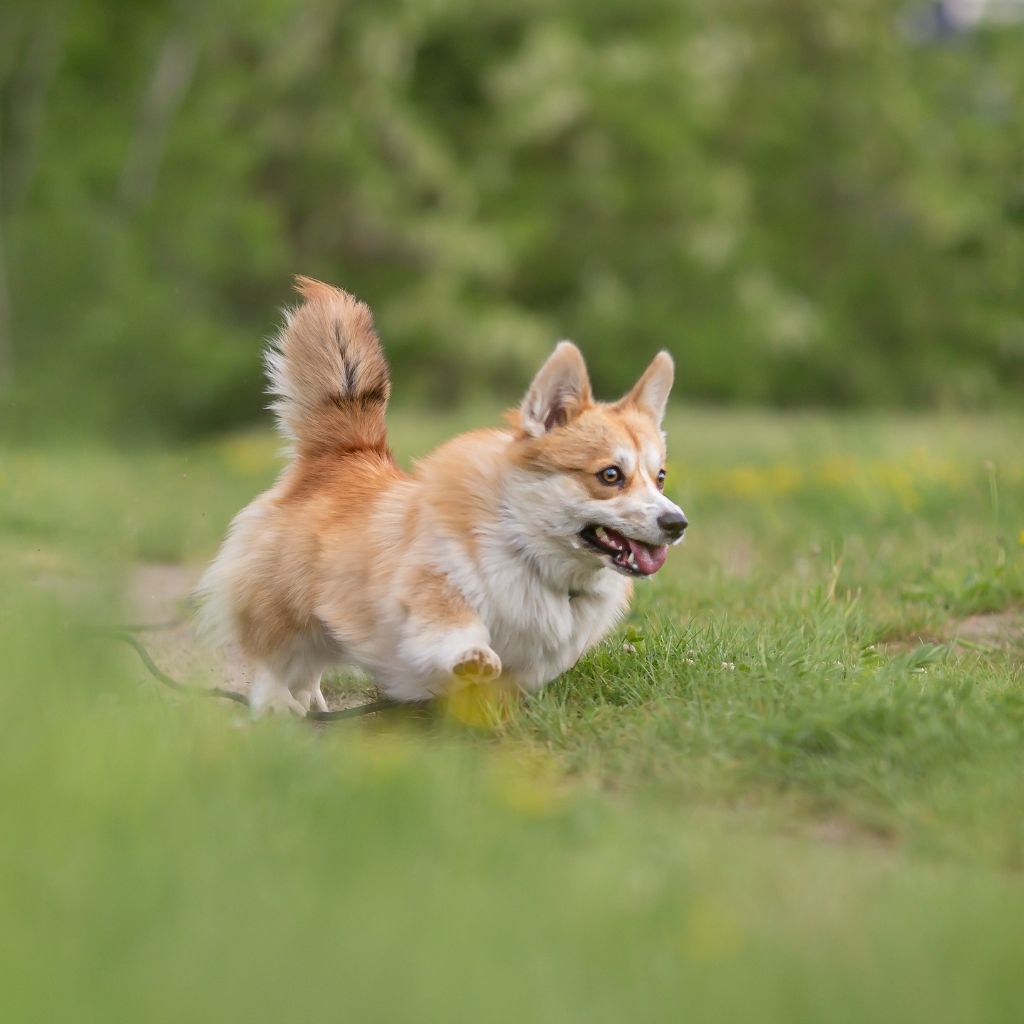
Biting is common in Pomeranians, regardless of their small stature. Understanding this behavior is vital to finding a solution.
Fear is a common cause for biting. If a Pomeranian is scared, it can bite as a self-defense mechanism.
Biting can also occur during play. Pomeranians sometimes play and bite without any malicious intent, and they can be a lot stronger than they think.
Puppies also bite when they are teething as this can relieve some discomfort.
Pomeranians can also bite to assert dominance. They are naturally bold, and biting can occur as a way to control a situation.
Finally, a Pomeranian can bite when they are angry or overstimulated. An overstimulated Pomeranian can snap or bite as a way to cope.
Common reasons for biting include:
- Fear
- Playfulness
- Teething discomfort
- Dominance assertion
- Frustration or overstimulation
Understanding these reasons helps owners address underlying issues and reduce biting incidents.
Pomeranian Behavior Problems: Beyond Aggression
Pomeranians, like many small breeds, can have various behavior issues. Beyond aggression, their challenges may include excessive barking or separation anxiety.
Excessive barking is a common complaint among Pomeranian owners. These dogs are vocal and may bark in response to sounds or strangers.
Separation anxiety is another frequent issue. Pomeranians form strong bonds, and when left alone, they may become stressed or destructive.
Resource guarding is sometimes seen in Pomeranians. This behavior involves growling or snapping to protect toys or food.
To manage these behaviors, owners should observe patterns. Understanding triggers allows for tailored interventions and better outcomes.
Common behavior problems include:
- Excessive barking
- Separation anxiety
- Resource guarding
- Destructive behaviors
Addressing these challenges requires patience and consistency. Tailored strategies can help improve your Pomeranian’s behavior.
How to Identify Triggers and Warning Signs
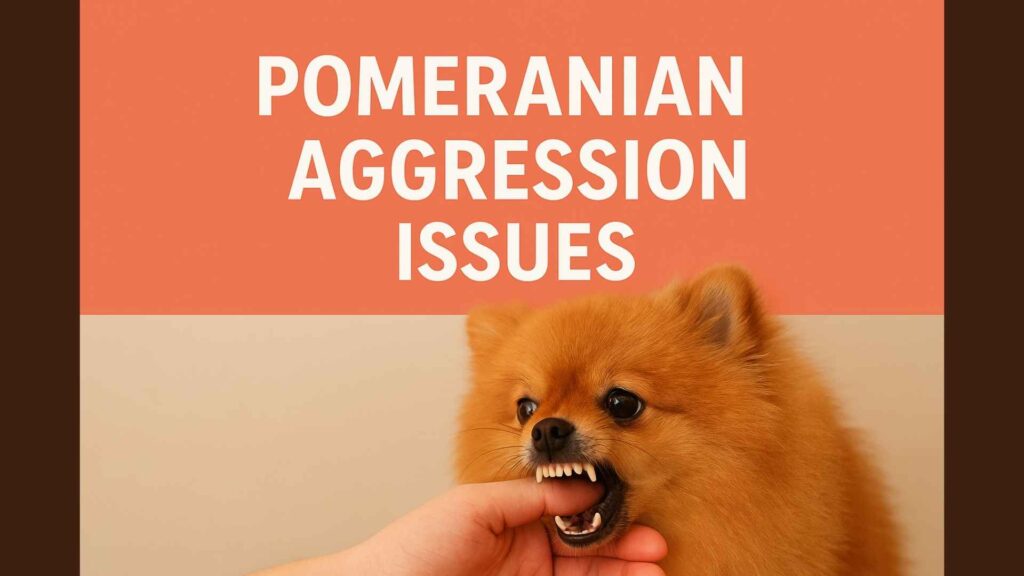
Understanding what triggers aggression in your Pomeranian is crucial. Observing your pet in different situations helps identify specific stressors.
Look for signs like a stiff body or a staring gaze. These behaviors often signal the intent to escalate to aggression.
Meeting new dogs or new people can help show Signs. Pomeranians can be sensitive to sudden movements or loud noises.
Warning signs may include growling or even barking. These behaviors usually denote some fear or discomfort.
Try to identify the consistent behaviors. For instance, aggression may be displayed when a dog is fed or when it is guarding some toy. These observations are needed to understand how to reduce the behavior.
Some common triggers and warning Signs are:
- Stiff body posture
- Fixed gaze
- Growling or snarling
- Backing away
Recognizing these signs early can help Pomeranians avoid aggression. Addressing aggression is only possible when the triggers are well understood.
The Role of Socialization in Preventing Aggression
Socialization is important in helping Pomeranians learn to cope, interact, and even give confidence in new situations.
Socialization helps Pomeranians cope in new situations; this lowers the risk for aggression.
To help a Pomeranian cope, socialization should start early. Gradual exposure to people, other animals, and new environments is the best.
Ensure their experiences are varied: this can include meeting new people, seeing different animals, and going to different places.
Socialization involves teaching dogs that new experiences are non-threatening. This expands their comfort zone and helps decrease aggressive behavior.
Socialization includes:
- New places and environments
- Different people and animals
- New experiences
- Quiet calm behaviors
Pomeranians can be aggressive if not properly socialized. Preparing socialization helps avoid this.
Training Strategies to Manage Aggression
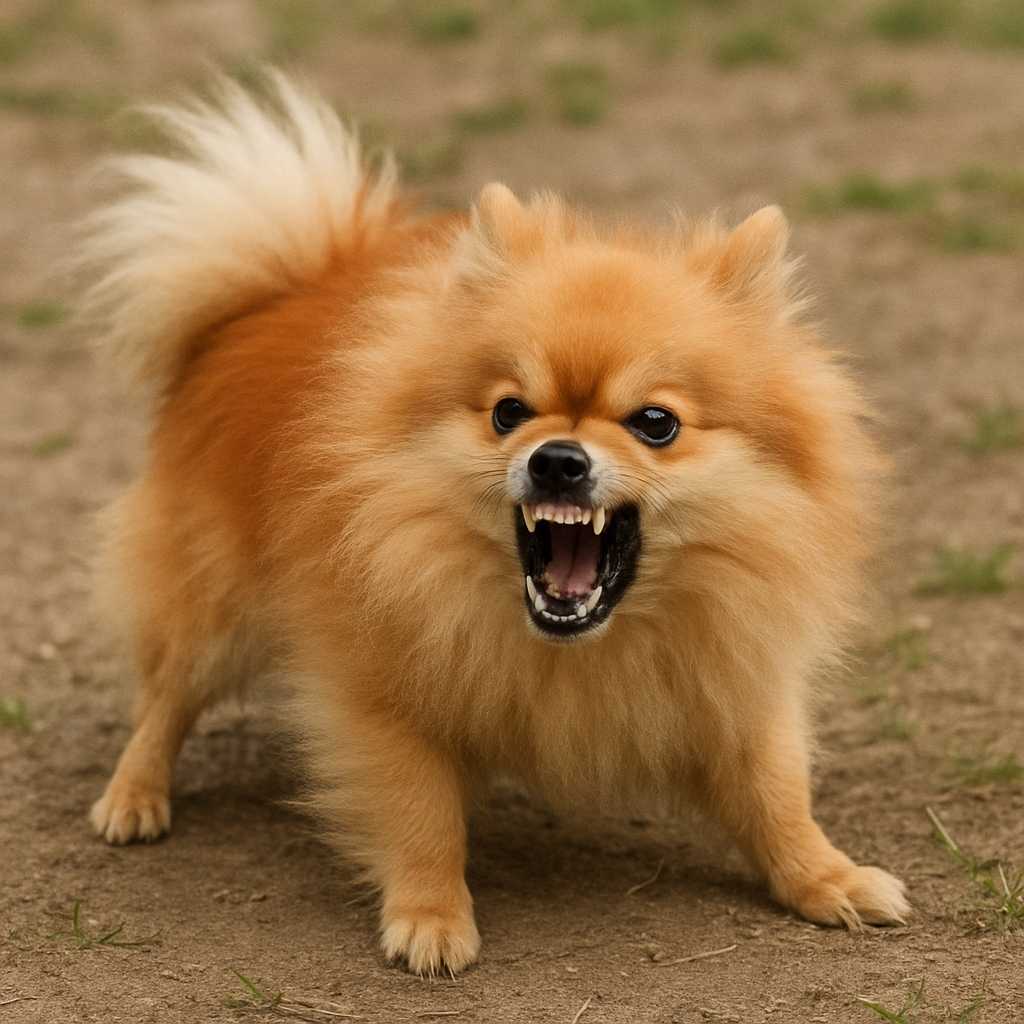
Aggression training in pomeranians starts by teaching basic commands. Establishing control by using commands like ‘stay’ and ‘come’ helps in aggressive situations.
Positive reinforcement involves giving treats for calm behaviors.
Avoid techniques that provoke aggression, these create a breach in trust and escalate aggression.
Set rules and boundaries; this helps dogs learn which behaviors are acceptable.
Desensitization involves gradual removal of a trigger. In a planned way, expose your dog to stimuli that trigger their aggression.
You may want to reach out to a professional if things are really bad or if nothing changes after a while. Some dog trainers and dog behaviorists provide specialized assistance as well.
Remember that you should focus on accomplishing the following:
- Basic obedience and command compliance
- Use of positive reinforcement
- Clear and consistent rules and limits
- Slow and gradual desensitization to the triggers
- Getting assistance when needed
Training your Pomeranian is more than a task. It takes time and dedication on your part and will eventually pay off.
Positive Reinforcement Techniques for Pomeranians
Positive reinforcement is rewarding the desired behavior you want a Pomeranian to repeat. It functions as a reward system for good behavior.
You should determine what each Pomeranian finds rewarding. Discoveries can include different dog treats, toys, and praises.
Be sure to reward your Pomeranian immediately after they display the behavior you were looking for.
Never reward a behavior you do not want. For any reinforcement to work, you must only reward positive behavior.
Consistent engagement is also important. It is a good idea to change up your rewards frequently to include treats, toys, and praise.
Important positive reinforcement tactics include:
- Finding motivators, whether treats or toys.
- Rewarding immediately for good behaviors.
- Not reinforcing bad behaviors.
- Using different rewards to keep interest.
Trust, and thus the bond between you and your dog, is built through consistent positive reinforcement. This also results in a well-behaved, confident Pomeranian.
Managing Resource Guarding and Territorial Behavior
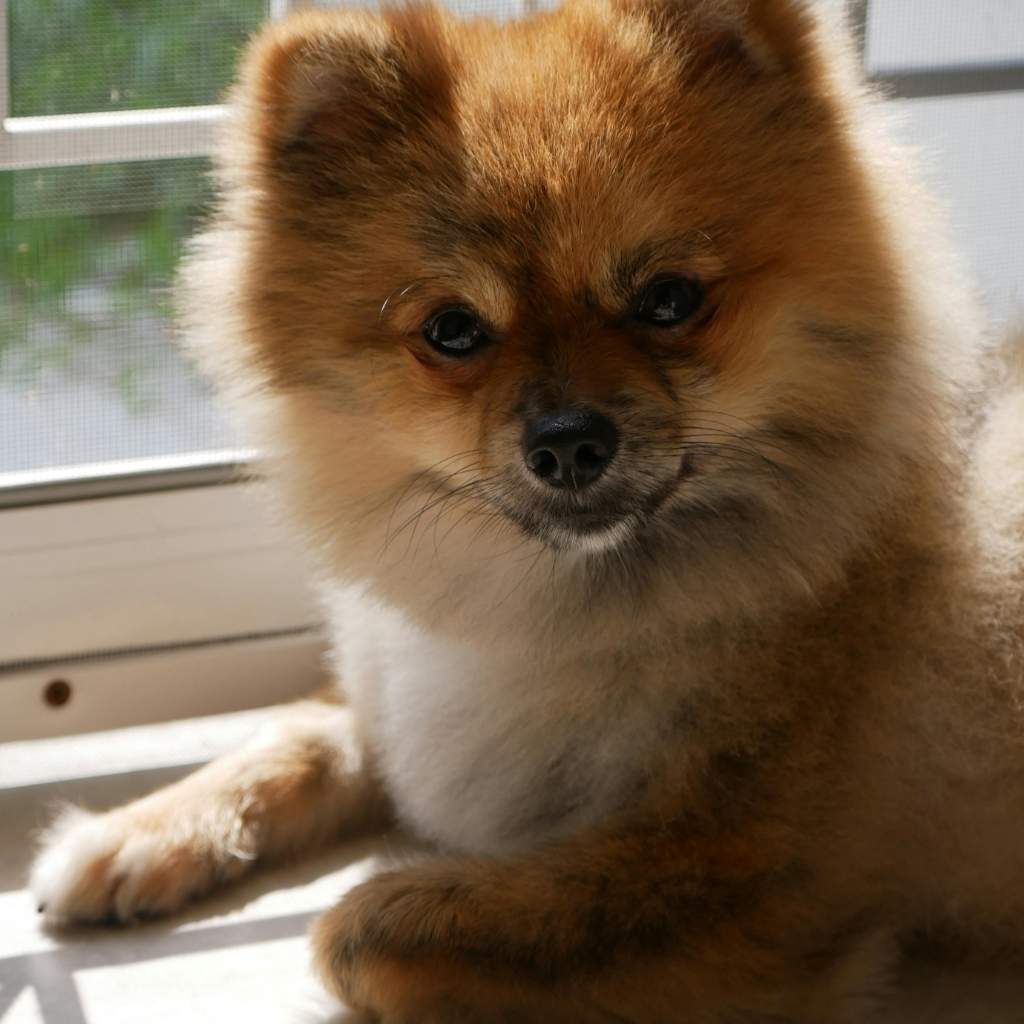
Resource guarding is protecting and keeping prized possessions safe, threatening or unthreatening. Pomeranians are known for displaying this behavior. They also sometimes defend their toys and food in aggressive ways.
To help teach your Pomeranian the drop command and reinforce it with rewards. This usually helps encourage teamwork.
Over time, and with safe distances and slowly decreasing them, you can help a dog become desensitized to others to their resources.
Territorial behavior may show aggression and require the use of positive reinforcement to associate new things with new places.
For the guarding behavior, you can use:
- The drop command for safe, released resources.
- Desensitization for comfort around others.
- New positive associations with people.
- Calm to reduce triggers.
Usage of these ideas surrounds and, therefore, helps guarding behavior resulting in a sociable Pomeranian.
Managing Aggression towards Canines and Humans
Occasionally, Pomeranians can be aggressive towards other dogs and unfamiliar people, which can be disruptive and problematic.
Start by looking closely at the triggers for aggressive behavior. Pay attention to the surroundings, the timing, and the interactions.
When introducing your Pomeranian to other dogs, make sure the setting is controlled for the safety and the manageability of the situation. Use leashes, and reward and praise your puppy for calm behavior.
When people come to Pomeranians, they should keep calm and positive. Encourage your Pomeranian to approach others at their own pace or get close to the person when ready.
Working with your Pomeranian on socialization skills will lower aggression. As they gain positive social experiences, their trust and confidence will increase.
Managing aggression will also require:
- Watching and recording what triggers their aggression.
- Leashed introductions for safety and manageability.
- Easing your Pomeranian to people.
Training and patience are vital, and so aggression will decrease.
When to Seek Professional Help
Sometimes, Pomeranians can be aggressive and owners are unable to control the situation at hand. In these instances, and when strategies to decrease aggression fail, it may be time for a professional.
Reach out to a trainer or a behaviorist who has worked with small dog aggression. You will get the support that will directly benefit the issues that your Pomeranian is having.
Seeing aggression when interacting with other people or other pets is a sign that you may need professional help, and waiting to seek help will only allow these incidents to happen again. Don’t wait for another incident when help is available.
Seeing aggression increase despite attempts to curb it is a sign that professional guidance should be obtained and waiting to seek help will only allow these incidents to happen more frequently.
Situations that demonstrate a need for professional help include:
- Having to control aggression toward other people and pets.
- Aggression that is scoped to be trained
- Aggression that is uncontrolled and increases suddenly with a trigger.
Having trusted help to advise you properly will help you stabilize the aggression that is proving difficult for you to cope.
The Importance of Routine, Exercise, and Mental Stimulation

For anxious dogs, predictability is helpful. Having a schedule that is predictable increases your Pomeranian’s confidence, which helps to calm the dog down when anxious.
Physical exercise that is Pomeranian appropriate on a regular basis helps to lower violence because it releases energy that Pomeranians tend to build.
To combat boredom and the unwanted behaviors it can stimulate, activities that require concentration should be incorporated because they also calm the dog down.
To stimulate your dog mentally, you can try any of the following:
- Pair exercise with the commands to be practiced
- Use toys that require a problem to be solved.
In a team-working and problem-solving effort to combat aggression, exercise, routine, and mental focus help to lower aggression levels and unwanted actions. They focus on the Pomeranian that will help.
Health Problems Leading to Aggression
Pomeranians can become aggressive due to underlying health issues. Pain and discomfort people problems can lead to irritability and aggression.
Systemic problems like dental issues and ear infections and their untreated sequelae can lead to behavioral problems.
Monitoring and identifying changes in behavior is vital to understand the potential health problems.
Health Problems Causing Aggression might include:
- Pain due to an injury
- Thyroid problems
- Neurological problems
A vet can figure out if health problems are an underlying cause. Preventative medicine is a great way to keep your Pomeranian healthy and avoid aggression.
Aggression might be avoidable if health problems are addressed in a timely and proactive manner.
Calm and Structured Environment
Pomeranian aggression issues can be minimized if the home environment is relatively stress free. Uncontrolled environments lead to exacerbated behavioral problems.
Pets feel safe and secure with a daily predictable routine. Predictability helps in trusting the owner which consequently reduces anxiety and aggression.
The following recommendations can help you establish a calming environment:
- Feeding and walking routines can help establish a calming environment.
- Having a designated space for animals and people to decompress.
- The less interruptions and distractions around the more pieces can be added to a calming environment.
- The sereneness of the space also relies on the consistency of the interactions. A well-defined space can be created by using direct and deliberate commands.
- Having predictable environments helps reduce the chances of aggressive behavior.
Structuring the environment to help manage behavior will reduce stroking the environment increases the stress and tension for you and your Pomeranian.
Common Mistakes When Handling Aggression
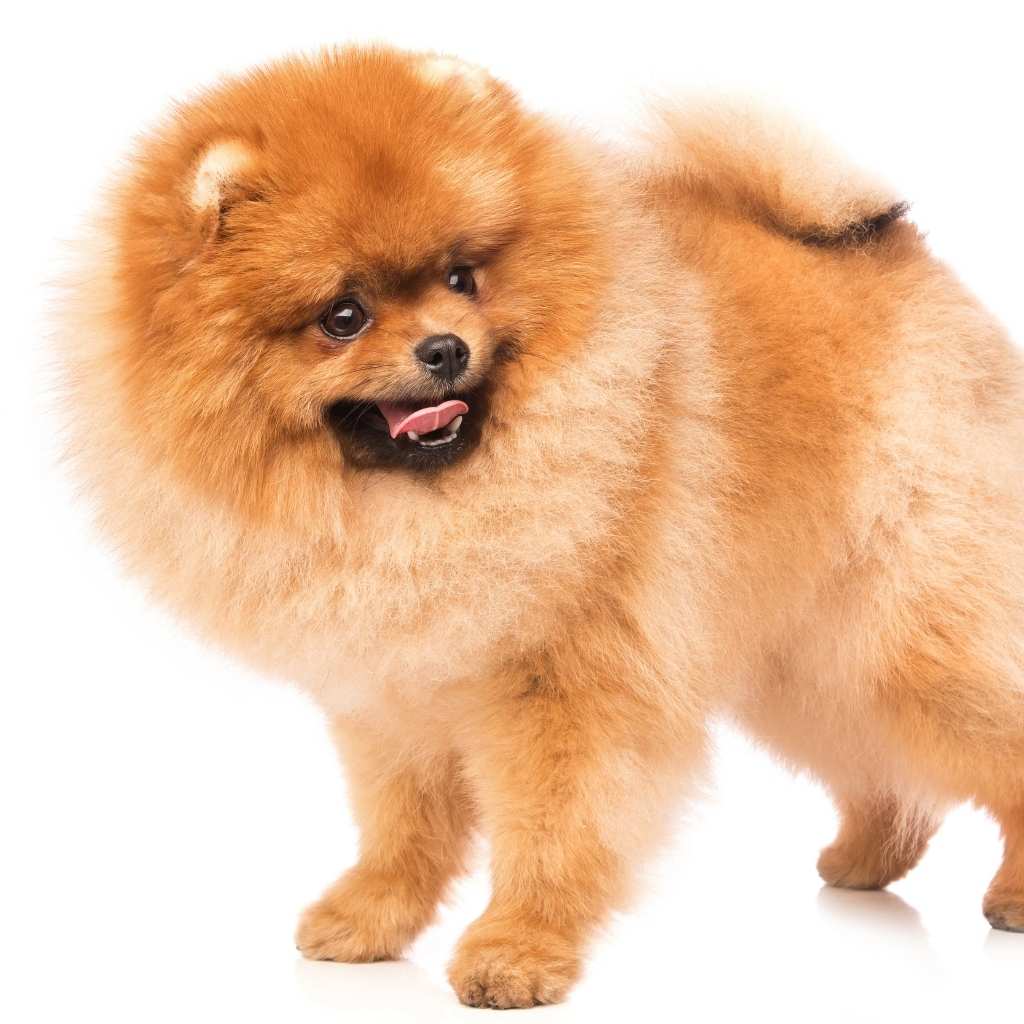
Having an aggressive Pomeranian will require you to be gentle and take your time. But there are some mistakes that are common that will stop you from getting any results.
Do not resort to yelling and physical punishment. Aggressive behavior will only get worse with that kind of punishment.
Being inconsistent is also a mistake. Confusing your Pomeranian will only make behavior problems worse. Make sure everyone in the household uses the same approach to training.
Not getting help from a pro will only make problems last longer. Severe aggression will require the help of someone like a dog trainer or behaviorist.
Preventing these mistakes is a lot simpler.
- Keep your calm and be patient.
- Use only positive methods to train.
- Get help from a pro when you need it.
These things will help you help your Pomeranian. Developing a strong relationship of trust and behavioral understanding will take time. But it will be worth it.
Key Takeaways and Final Thoughts
Understanding and managing Pomeranian aggression issues comes with effort and appreciation as well as commitment. Early intervention with consistently applied training is critical for success. Recognizing the specific triggers for aggressive behaviors is a key to preventing the escalation of aggressive behaviors.
One of the key areas to focus on problem behaviors is the socialization or lack thereof. Interaction with other dogs and humans helps address primitive behaviors, such as excessive territorial tendencies and fears. Positive reinforcement with training provides mental stimulation and deepens the relationship with the owner.
Take things one step at a time. Bothering your Pomeranian and their problems is a process of time.
Key Takeaways:
- Recognize the aggression triggers
- Encourage aggressive behavior training and socialization
- Apply positive reinforcement training
With these applied, one sets a secure regulated environment for your Pomeranian. This builds the confidence and support, your Pomeranian needs. Self-educated owners, understanding canine behavior empowers positive interactions with their pet, and understanding and commitment creates a positive life.
Improve training and knowledge on managing Pomeranian aggression safely, including biting and other behavior issues for a better-balanced pet.
FAQs
Underlying causes of aggression can be related to fear, poor socialization, pain, learned behavior, or resource guarding. A vet check is advisable to rule out any medical conditions and identify and assess any specific triggers involving people, dogs, food, or noise.
Pomeranians commonly exhibit excessive barking, separation anxiety, resource guarding, leash reactivity, and “small-dog” dominance. Most behavior problems stem from unsatisfactory socialization, inconsistent boundaries, or inadequate mental and physical stimulation.
Most aggressive behavior can be almost completely fixed with a behavior-modification plan that ensures positive reinforcement, professional guidance, and consistent management of the dog, along with desensitization and counter-conditioning. The commitment of the owner, along with the dog’s history and the cause of the behavior are the primary factors that will determine the outcome.
Structure and consistency when “disciplining” dogs can be achieved with calm, desired behaviors getting rewarded while setting consequence measures, such as short time outs and the removal of rewards. However, yelling and physical discipline will increase fear and aggression, while clear rules and predictable routines are effective.
You can de-escalate the situation by removing the trigger, adopting neutral body posture, and providing the dog with a calm, structured routine that includes space and disengagement. For persistent anger, desensitization and positive reinforcement will need to be used. A behaviorist or vet can be consulted, as needed.
